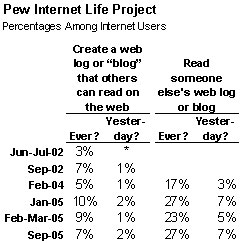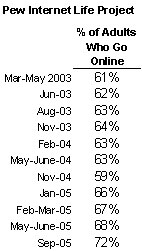Gallup has a new report out today updating data released last year on self-reported blogs readership. Senior Editor Lydia Saad concludes that growth in blog readers over the last year “was somewhere between nil and negative.” As Gallup typically makes reports on its subscription-only site available for free for the first 24 hours after their release, I wanted to post the link as soon as possible this morning. Time allowing, I am hoping to post some thoughts on Gallup’s report later today.
In the meantime, readers may want to compare the new Gallup data to similar data reported by Pew Internet Life Project (here and here) and refer back to my commentary on Gallup’s report on this topic last year.
UPDATE (2/11): First, I am told that access to the Gallup report should remain free through the weekend.
Second, it is tempting – very tempting – to quibble with the report’s prominent comparison of two questions that are, by Gallup’s admission, “not exactly comparable.” Still, the two most important findings are reasonably clear-cut and supported by similar data from the Pew: The percentage of regular blog readers among those who go online is very small and has not increased significantly over the last year.
Consider the four questions about blogs tracked over the last year by the Pew Internet Life Project. They ask about both reading blogs and about “creating a blog.” As with all Internet activity that they track, Pew asks respondents whether they have “ever” done that activity and then whether they did so “yesterday.” [Note: The Pew Internet studies are usually conducted over a month’s time, so these statistics average a month’s worth of “yesterdays” providing a more accurate measure of what people do on a “typical” day].
As the table below shows, reports of blog readership grew between 2004 and 2005, but have remained essentially flat during 2005.

Keep in mind that both Gallup and Pew typically report blog readership as a percentage of “Internet users.” Thus, as the Gallup report points out, blog readership is an even smaller percentage of all adults. On the other hand, continuing growth in the percentage of Americans who go online will increase the aggregate number of blog readers even if the percentage of Internet users remains constant. Here the Gallup and Pew data appear to be somewhat at odds: Gallup’s base of Internet users was slightly larger a year ago (76%) than in their December 2005 sample (73%), although the report tells us that “the percentage of Americans who use the Internet to any degree has not changed during the past three years.” The Pew surveys, on the other hand, show a small upward trend over the same span, from 61% in early 2003 to 72% in September 2005.

[Note: the source for the data in both tables is the “Usage Over Time” spreadsheet available from the Pew Internet Project, with important caveats spelled out in the separate “tip sheet.”]
Yes, MP is a blogger, and so he certainly appreciates Lydia Saad’s final acknowledgment that despite the relatively low readership, blogs may still exert a “disproportionate influence…on opinion leaders, political insiders, and modern news media.”
But oh for some empirical data to test that hypothesis.
Blogs aren’t growing but is anyone reading them?
Are blogs growing? Sifry works for Technorati, a blog search engine and community site. Sifry’s blog, Sifry’s Alerts says that the number of blogs is doubling about every 5.5 months. He estimates that approximately 2.7 million bloggers post to their…
Gallup har räknat bloggläsare
Bloggläsandet bland amerikanska nätanvändare växer inte längre som tidigare, utan sjunker till viss del, enligt en ny Gallup-undersökning: However, according…
While the Gallup Poll dismisses the number of blog readers, at 40 million, how does that compare to the actual numbers of readers of newspapers nationally? Or of TV news watchers?
Blogging, requiring a modicum of literacy, likely ranks well against national print news readership. Maybe the percentage isn’t growing, but as I recall, it’s shrinking for the print media, so blogs are doing well to maintain a 40 million readership base.
We Has ARRIVED!
Want to know when you have made the Big Time? It’s when people begin to try to knock you down for being there! It is a given that when a person or group achieves a measure of success and insularity…
Hmmm. I guess that blogs nowadays are not able to replace mass media. The reason is clear – the biggest part of blog-posts are just some short and broken statemens. In mass media we always have at least normal text with arguments and structure.
Gallup has a new report out today updating data released last year on self-reported blogs readership. I think that its an awesome report.